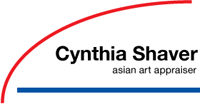The month of August I was obsessed, and still am, with the fair market valuation of the more than 800 textile properties from the collection of textile artist Peggy Osterkamp. Working with this artist has been a privilege, viewing the top 20% of quality of whatever cloth it is. This collection was put together over six decades, always with the curated eye of a textile artist. What a pleasure and challenge this project continues to be.
This has been a wonderful experience for me, my eyes have been served a visual feast, and I have sought advice from colleagues all around. Imagine how it feels to have someone paying me good money for my fifty years of experience handling textiles. This is my ‘down the yellow brick road’ moment. I take my work seriously and realize and appreciate the trust involved.
The origins of the collection are primarily Japan and India and with ikats of Afghanistan, and a sampling of Chinese minority textiles and much more. Yesterday I researched Philippine abaca cloth, or fiber made from pineapple. One example was a ‘sculpture’ purchased in the Philippines made from pina or abaca, a blouse with exaggerated puffy sleeves, likely made in mid 1900’s by local artist. This is labeled ‘Imelda Marcos’.
Another property is a Japanese obi made from silk and wasp nests in a checkerboard fashion. Yes, wasp nests. This was purchased from artist. At first I wondered how such a fragile material could be used for clothing, afraid to touch. I watched a YouTube video on wasp’s activity and their nests. The nests are quite sturdy and needed a cleaver to separate so no worry about fragility for use in obi.
Included in the collection, are many Japanese cotton fabric sample books. One has pages only of stripes, another has only plaids, yet another made from a new blank sample book with only the best of the indigos by one of the known fine Kyoto textile dealers, think a Levi fabric sample book. There are at least five Japanese boro, from large to small, beautiful examples of blue patchwork cotton cloth. Each one as they were pulled out for examination took my breath away. Usually I see one or two examples. Here were many, all very fine samples of the genre.
Another example of my awe was entering her studio and suspended from the ceiling was a Japanese hearth hook, a bamboo pole with carved wood fish as balance, a hanging tea kettle with lid with long iron tweezers to attend to the ashes in the fire. All of these components are usually seen separately on display or for sale and all are collectable. That all parts were represented made me see the artist involved, Peggy Osterkamp, she saw ‘the how to use’ part. Many stop at the beauty of one object, the jizai or carved hook, or maybe the iron teapot with signature on lid. Here on display was the eye of a working artist.

